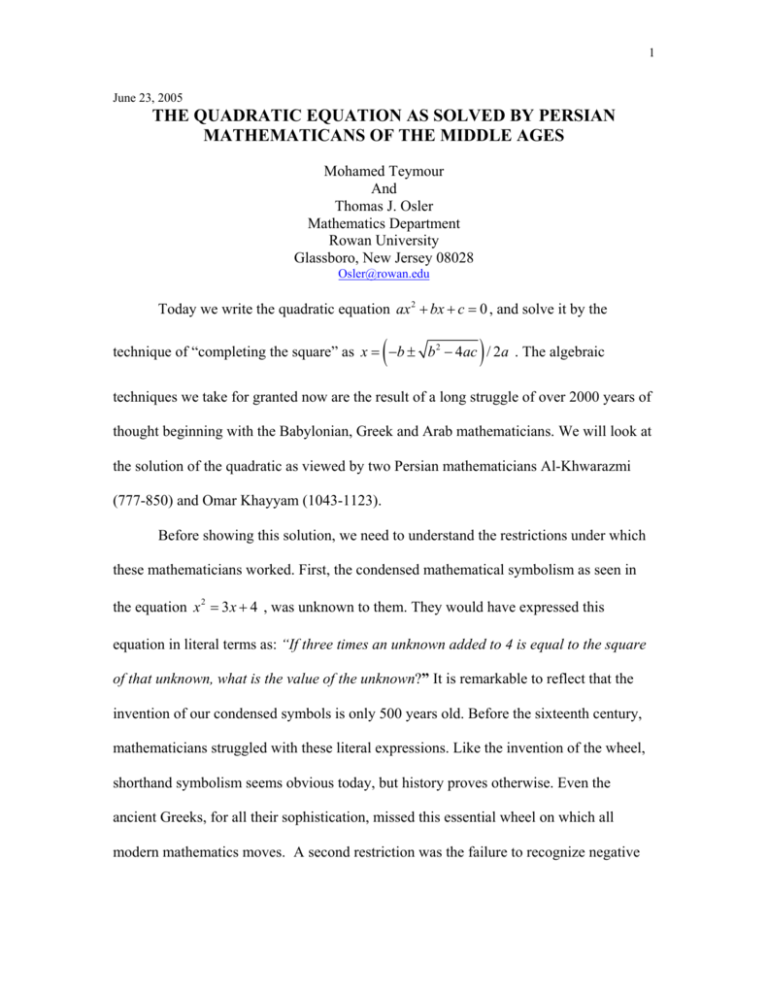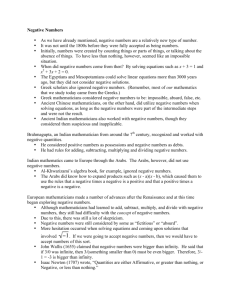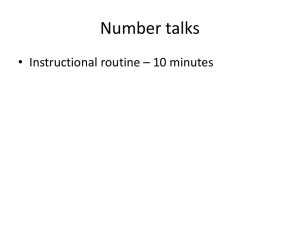THE QUADRATIC EQUATION AS SOLVED BY ARAB
advertisement

1 June 23, 2005 THE QUADRATIC EQUATION AS SOLVED BY PERSIAN MATHEMATICANS OF THE MIDDLE AGES Mohamed Teymour And Thomas J. Osler Mathematics Department Rowan University Glassboro, New Jersey 08028 Osler@rowan.edu Today we write the quadratic equation ax 2 + bx + c = 0 , and solve it by the ( ) technique of “completing the square” as x = −b ± b 2 − 4ac / 2a . The algebraic techniques we take for granted now are the result of a long struggle of over 2000 years of thought beginning with the Babylonian, Greek and Arab mathematicians. We will look at the solution of the quadratic as viewed by two Persian mathematicians Al-Khwarazmi (777-850) and Omar Khayyam (1043-1123). Before showing this solution, we need to understand the restrictions under which these mathematicians worked. First, the condensed mathematical symbolism as seen in the equation x 2 = 3 x + 4 , was unknown to them. They would have expressed this equation in literal terms as: “If three times an unknown added to 4 is equal to the square of that unknown, what is the value of the unknown?” It is remarkable to reflect that the invention of our condensed symbols is only 500 years old. Before the sixteenth century, mathematicians struggled with these literal expressions. Like the invention of the wheel, shorthand symbolism seems obvious today, but history proves otherwise. Even the ancient Greeks, for all their sophistication, missed this essential wheel on which all modern mathematics moves. A second restriction was the failure to recognize negative 2 and complex numbers. To mathematicians of the middle ages, all numbers were zero or positive. Figure 1 In the spirit of Al-Khwarazmi and Omar Khayyam, we now solve the equation x 2 = bx + c , in which x, b, and c are assumed to be positive. Refer to Figure 1 and make the following constructions: 1. Construct the square ABCD of side x. (Since x is unknown, imagine any quantity greater than b.) 2. Find point E on BC such that EC has length b. 3. Construct EL parallel to AB. Notice that CDLE has area bx and since x 2 = bx + c , ABEL must have area c. 4. Bisect EC at F and construct the square EFGH with side length b / 2 . 5. Extend FG to I so that IG = BE . 6. Notice that LJ = HE = b / 2 . 3 7. It is now clear that KBFI is a square. 8. The rectangles AKJL and JHGI are congruent. 9. Thus the area of KBEHGI = area of ABEL = c . 2 b 10. The square KBFI has area EFGH + KBEHGI = + c . 2 11. The side of this square KBFI is BC − FC = x − 12. Thus x − b . 2 b b2 b + b 2 + 4c = + c and we have the solution x = . 2 2 4 Al-Khwarazmi used the geometrical method just described to find an algebraic solution for the specific equation x 2 = 3 x + 4 , while Omar Khayyam solved the general equation x 2 = bx + c . Al-Khwarazmi (Also known as Muhammad Ben Musa AlKhoarazmi) was born in Khwarazm, a region in northern Persia. He was a scholar at the House of Wisdom called ‘ Bit Al-Hikma’, in Baghdad (Iraq), where there was a large library and a famous observatory. Within the walls of this institution lived some of the greatest scientists of the period. It housed translators, busy rendering into Arabic scientific classics written in Sanskrit, Pahlavi, ‘the classical language of Persia’, Syriac and Greek [4]. Khwarazmi’s most famous algebra work is called “ Al-jabr Wal Moqabelah” [3]. It was the first algebra book ever written. It is described in [4] as the best known algebra for Europeans until Viete the French Mathematician (1550-1603) extended algebra and trigonometry in the 16th century. Western Europeans learned about this book after it was translated into Latin in the twelfth century. The book is over 1200 years old and the name of algebra is originally taken from the name of this book .The word ‘Jabr’ means 4 transposing (when moving a negative term and making it positive) and completing. And “Moqabelah” means canceling the same terms from both sides of an equation. Khwarazmi’s book contains first and second-degree equations with their geometric solutions, the four basic arithmetic operations, topics in areas and volumes, and problems related to inheritance. Omar Khayyam was a celebrated Persian mathematician, astronomer, philosopher, and poet. Khayyam was born in Nishapour (Iran) and worked as an astronomer in the observatory of Isfehan (Iran). He introduced an accurate calendar called “Tarikh Jalali”. This calendar is superior to the Georgian calendar and is still used by most Near Eastern countries. He also worked on the triangular array known today as Pascal’s triangle. Written in Farsi and in Arabic, Khayyam’s “Jabr O Moqabeleh “ or “Maqalat Fi Al Jabr Wal Moqabelah” [2], classified equations according to their degree and gave rules for solving quadratic equations which are very similar to the ones used today. He also gave a geometrical method for solving cubic equations with real roots [1]. The fame of Khayyam as a mathematician has been partially eclipsed by his famous poetry book “Rubaiyat” translated by Edward Fitzgerald into English in the middle of the 19th century. References: [1] George Gheveghese Joseph, The Crest of the Peacock, Penguin Books, London-New York, 1991, page 303. [2] Omar Khayyam, Hakim Omare Khayyam as an Algebraist, (translated by from Arabic to Farsi by G. H. Massaheb), 2nd edition, published by UNESCO in Iran, Tehran, 2000. 5 [3] Muhammad Ben Musa Al-Khwarazmi,(Translated by Husayn Khadiw-I Djam from Arabic to Farsi), Kitab Al-Jabr Wa’l Muqabeleh, Farsi publication, Issue no. 44, Published by UNESCO in Iran, Tehran, 1983. [4] V.S. Varadarajan, Algebra In the Ancient And Modern Times, Hindustan Book Agency-AMS, Mathematical World, Volume 12, 1998, pages 45 and 65.





